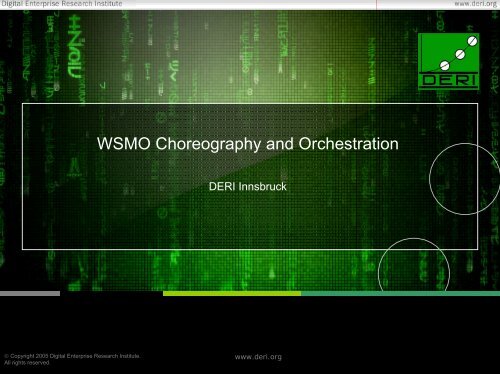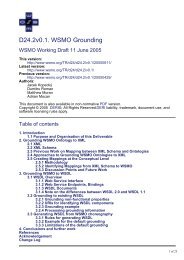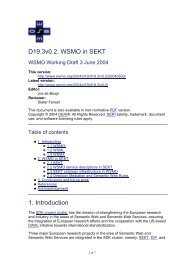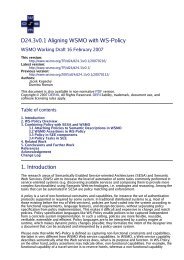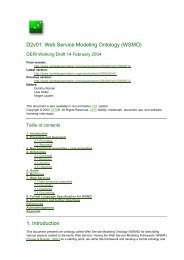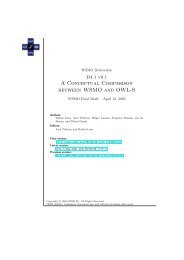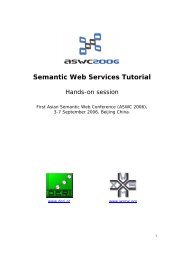Current state of WSMO Choreography and Orchestration
Current state of WSMO Choreography and Orchestration
Current state of WSMO Choreography and Orchestration
- No tags were found...
You also want an ePaper? Increase the reach of your titles
YUMPU automatically turns print PDFs into web optimized ePapers that Google loves.
Overview• <strong>WSMO</strong> Overview– Ontologies– Service Descriptions: Conceptual Level:• Capabilities• Interfaces:– <strong>Choreography</strong>– <strong>Orchestration</strong>• Requirements on behavioral <strong>and</strong> functional description <strong>of</strong>services• Modeling choreography interfaces using ASMs – currentapproach• Open issues3
<strong>WSMO</strong> Overview: Conceptual Model4
Ontology Example:In WSML you can define:• Rules/axioms over these concepts <strong>and</strong>attributes• Integrity constraints• Taxonomies (i.e. subconcept relationships)• Instancesetc.6
<strong>WSMO</strong> Overview: Web Service Descriptions• Capability– Precondition• Information space prior execution– Assumption• State <strong>of</strong> the world prior execution,• "usual assumptions" as opposed to "checked conditions"– Postcondition• Information space after execution• can also be conditional wrt. the the pre-cond's/ass– Effect• Real World State <strong>of</strong> the world after execution• can also be conditional wrt. the pre-cond's/ass• Interface– <strong>Choreography</strong>• interface <strong>of</strong>fered by the WS to communicate with the client– <strong>Orchestration</strong>• How the Web service uses other Web services to achieve its functionality8
Web Services: Capability <strong>and</strong> Interfaces- Advertising <strong>of</strong> Web Service- Support for WS DiscoveryCapabilityfunctional descriptionRealization <strong>of</strong> WSfunctionality by usingother Web Services- Functional decomposition- WS Composition<strong>Choreography</strong><strong>Orchestration</strong>Behavior Interfacefor consuming WS- Messages- External VisibleBehavior- ‘Grounding’Web ServiceImplementation(not <strong>of</strong> interest in WebService Description)WSWS9
Capability example, current approach:•maybe better exists ?order10
Scope <strong>of</strong> capability• facilitate discovery without exposing full functionality <strong>of</strong>the service, accept a certain level <strong>of</strong> abstraction• web service as „function“ or set <strong>of</strong> <strong>state</strong> transitionsdescribed by– currently: precondition + postcondition, assumption+effects– <strong>state</strong> invriants missing? temporal <strong>state</strong>ments missing?e.g. „the service does not charge my credit card before areservation has been made“12
Scope <strong>of</strong> choreography• Define the behavioral interface <strong>of</strong> the service (inputs expected,outputs, possible message exchange patterns) in a way that allowsto automatize interaction with the service• Should facilitate composition:– Should on the one h<strong>and</strong> allow me to infer in which way to interact withthe service in order to achieve a certain output (as far as specified)– Should on the other h<strong>and</strong> not duplicate the internal functionality <strong>of</strong> theservice.--> Trade<strong>of</strong>f needed between precise description <strong>of</strong> what the servicedoes <strong>and</strong> ease <strong>of</strong> modeling.• Should not define exact content <strong>of</strong> messages exchanged or bind toone particular comm paradigm, but facilitate different groundings(e.g. to WSDL, TripleSpace (future))13
Overview• <strong>WSMO</strong> Overview• Requirements on behavioral <strong>and</strong> functional description <strong>of</strong>services• Modeling choreography interfaces using ASMs –current approach– "Ontologized" ASMs– Ontologies as <strong>state</strong> signatures– Instance updates instead <strong>of</strong> function updates– Example• Open issues14
<strong>WSMO</strong>: <strong>Current</strong> <strong>Choreography</strong> description• ASM Model as the basis• State Signature– State as an extension <strong>of</strong> a <strong>WSMO</strong> ontology, defined through set <strong>of</strong> instance<strong>of</strong> Concepts <strong>and</strong> Relations <strong>of</strong> an ontology– Concept <strong>and</strong> Relations have assigned roles in, out, shared, controlled• Transition Rules– Condition• <strong>Current</strong>ly restricted to WSML Logical Expression to support onlyconjunctions/disjunctions <strong>of</strong> instance membership <strong>and</strong> attribute value <strong>state</strong>ments• Describes the current <strong>state</strong> in terms <strong>of</strong> the attribute-values <strong>of</strong> the instance data• Question: How to create new instances, or repsectively how to later on reference them?– Updates• Define the changes <strong>of</strong> the attribute values <strong>and</strong> instance data in the <strong>state</strong>• Macros:– add– delete– Update• Attention: Via axioms in ontologies, updates can have non-local effects!15
<strong>Choreography</strong>: State Signature• State– Defined by a set <strong>of</strong> imported ontologies• Modes– in: modified by the environment, read by the choreographyinstance– out: read by the environment, modified by the choreographyinstance– shared: read by both the environment <strong>and</strong> choreographyinstance– controlled: read <strong>and</strong> modified by the choreography instance only– static: cannot be modified by neither the choreography instancenor the environment16
<strong>Choreography</strong>: Transition Rules• If condition then rules– The condition is a quantified WSML Core logical expressionmade up <strong>of</strong> memberOf <strong>and</strong> hasValue atoms only.– The rules take the form <strong>of</strong> normal transition or update rules• Forall variables with condition do rules endForall– The variables are WSML variables– The condition is a WSML Core logical expression made up <strong>of</strong>memberOf <strong>and</strong> hasValue atoms only.– The rules take the form <strong>of</strong> normal transition or update rules• Choose variables with condition do rules endChoose– Same as Forall except that rules are to be executed are chosennon-deterministically17
<strong>Choreography</strong>: Update Rules• Instead <strong>of</strong> assignments for functions we define Basic updates <strong>of</strong> theinstances <strong>of</strong> an ontology:– add(fact)– delete(fact)– update(fact new)– update(fact old=> fact new)• A fact takes the following form:– a[b hasValue c]– a memberOf b– …together with syntactic variants• update(a[b hasValue from => to]) :-delete(a[b hasValue from])add(a[b hasValue to])18
Few descriptions, current approach seems toverbose… one try here:• Header:19
Few descriptions, current approach seems toverbose… one try here:• Suggestion: in order to model control flow, make use <strong>of</strong> control <strong>state</strong>ASMs:• Allows to "emulate" control flow, sequence, etc.• Allows graphical modeling• Syntax proposal for <strong>WSMO</strong> in the next slide…20
Few descriptions, current approach seems toverbose… one try here:21
Open discussions about thissyntax proposal, too verbose?Can we reason about suchdescriptions?How does the ASM Model alignwith ontology reasoning?22
Overview• <strong>WSMO</strong> Overview• Requirements on behavioral <strong>and</strong> functional description <strong>of</strong>services• Modeling choreography interfaces using ASMs – currentapproach• Open issues– Grounding– <strong>Orchestration</strong> vs. Composition language– Notions <strong>of</strong> matching– Formalisms for composition– Model theoretic semantics <strong>of</strong> chor language– Interesting challenge questions23
Grounding• How does this fit together with existing WS st<strong>and</strong>ardssuch as WSDL• Grounding to WSDL means mapping input/output toWSDL operations in a probably pre-existing WSDL file• Ontology instances need to be wrapped into XMLmessages conforming with an XML Schema(lifting/lowering)• Question: What needs to be "sent over the wire"? Thefull object? Only a reference?– How are instances sent over the wire?– (How) are only references sent over the wire?24
<strong>Orchestration</strong> vs. Composition language• <strong>Orchestration</strong> currently defined as follows:• "How the Web service uses other Web services to achieve its functionality"• Basic idea based on current approach: Extend the language for choreographyinterface by calls to WW <strong>and</strong> WG mediators, i.e. mediators which specify howa certain external service or goal maps is invoked by the service itself.• Should also include/realte to grounding• Shall describe how other services or goals are called on an abstractor executable level:1. could be used to describe service templates (which modulo binding <strong>of</strong>goals is even executable)2. executable compositions (where no goals appear)3. loose abstractions which are not executable4. could be tied to/reuse the inputs/outputs described in the thechoreography or not.• How? not clear yet! But there are several requirements:- We need a language to describe 1)+2) for several projects- Should be possible to relate to a graphical representation languagee.g. UML activity diagram style.25
Notions <strong>of</strong> matching• What does it mean that two capabilities match?– Partly defined, but open questions around semantics forcapabilities• What does it mean that 2 choreographies match?– Basically what needs to be proved is that in all trajectories <strong>of</strong>service x , all trajectories <strong>of</strong> service y provide necessary input orconsume output <strong>of</strong> the other service– Process algebras have bi-simulation– How does this extend to collaborations/interleaving <strong>of</strong> multipleservices26
Formalisms for composition:• Most current approaches to composition doe sequentialcomposition only.• For a service which exposes a complex MEP, this wouldmean (very unlikely) that all service inputs are availableupfront.• More likely: composition by interleaving several complexservices should be possible collaboration!27
Model theoretic semantics <strong>of</strong> chor language• We need to reason about possible trajectories <strong>and</strong>execution histories e.g. for matching• This is possible in FLOWS,• Do ASMs provide this (translation to a formal logic)?• Can we link to FLOWS?28
Interesting challenge questions:• some issues <strong>and</strong> one use case discussed with RickHull…29
HR1: a Hotel Recommendation Service?find_hotel_request(…, city: c, criteria: cr1, …)!hotel_recommendation(hotel_name: hn, city: c, description: d, …)?find_diff_hotel?request_reservation(person_name: pn, hotel_name: hn, start_date: sd, end_date: ed,further_criteria: cr2, …)if fail then!attempt_failed?find_diff_hotel?find_diff_hotel?endattempt_reservation(person_name: pn, hotel_name: hn, start_date: sd, end_date: ed,criteria: cr1+cr2, …)?endif success then!reservation_avail(person_name: pn, hotel_name: hn, start_date: sdend_date: ed, room_type: rt, time_out: to, …)?commit_for_reservation(person_name: pn, hotel_name: hn, start_date: sd,end_date: ed, credit_card#: cc, …)commit_reservation(person_name: pn, hotel_name: hn, start_date: sd,end_date: ed, criteria: cr1+cr2, …)!confirm_reservation(person_name: pn, hotel_name: hn,start_date: sd, end_date: ed,criteria: cr1+cr2, confirm_number: cn)• A guarded automaton defining advertised/observable behavior <strong>of</strong> webservice Hotel_Recommendation_1 (HR1), in the spirit <strong>of</strong> Colombo model• Message receives indicated by ‘?’; message sends indicated by ‘!’; atomicprocess invocations have no preceding punctuation symbol• The one (or more) atomic process(es) used to find the “next” recommendedhotel are not included in this advertisement. However, the attempt_reservation <strong>and</strong> make_reservation atomic processes are explicitly specified• We are not specifying in detail the ontology for “criteria”, “room_type”, etc.30
Ontology Concepts/Relationsmanipulated by HR1• hotels_recommended_so_far(hotel_name)– Internal to each occurrence <strong>of</strong> service HR1– Ensures that the same hotel is not recommended twice in one occurrence• hotel_room_inventory(hotel_name, city, room_type, quantity, …)– For this example, assumed to be a static relation– It is also assumed to be a single, virtual relation (since in practice different hotels wouldprobably own/administer their own data). We assume that HR1 provides an abstracted,integrated view <strong>of</strong> the relations <strong>of</strong> all the hotels– Accessed by occurrences <strong>of</strong> HR1 (along with accesses to hotel_reservation <strong>and</strong>hotel_reservation_request) to check on availability <strong>of</strong> given type <strong>of</strong> room on given dates– May have additional fields, e.g, for amenities, such as pool, TV, …• hotel_reservation(hotel_name, room_type, person_name, start_date,end_date, credit_card_#)– As with hotel_room_inventory, assumed to be a single, virtual relation– Shared by all occurrences <strong>of</strong> service HR1 (<strong>and</strong> possibly other services)• hotel_reservation_request(hotel_name, room_type, person_name,start_date, end_date, time_out)– As with hotel_room_inventory, assumed to be a single, virtual relation– This is used to store commitments made by a hotel, that it will provide a reservation tothe person, once a credit-card number is provided31– The time_out indicates the time when this commitment will expire
Challenge topic 1 (slide 1 <strong>of</strong> 2)• Can we map the notions <strong>of</strong> capability <strong>and</strong> choreographyinto FLOWS, so that we can precisely formulate thequestion “Does choreography Ch achieve capability Ca?”– Notion <strong>of</strong> “achieve” will need to be defined, <strong>of</strong> course• This notion will probably focus on the net effect <strong>of</strong> the choreography onsome set <strong>of</strong> (accessible) fluents• In the general case we expect that verifying achievability will beundecidable. The results <strong>of</strong> Vianu et. al. might provide a starting pointfor finding restrictions on Ch <strong>and</strong> Ca so that achievability becomesdecidable <strong>and</strong>/or tractable• Solving this challenge can provide one way to formallyspecify/verify that a given service described by achoregraphy satisfies a user-specified goal (capability)• Can ask analogous question for a choregraphy <strong>and</strong> anorchestration32
Challenge topic 2 (slide 1 <strong>of</strong> 4)• Recall the service HR1. It would be useful to be able toinfer the following property:– “Once person p makes a hotel reservation using HR1 <strong>and</strong> receivesa confirmation number, then this reservation cannot be modified orcanceled except by service occurrences invoked by p.”• Note – inferring this property involves two distinct kinds <strong>of</strong>reasoning– Reasoning about the effect <strong>of</strong> occurrences <strong>of</strong> HR1 on variousfluents– Reasoning about the effects <strong>of</strong> occurrences <strong>of</strong> HR1 <strong>and</strong> otherservices that happen to touch the hotel_reservations relation• It appears that this desire <strong>of</strong> a client cannot be expressedusing simply the <strong>WSMO</strong> notion <strong>of</strong> “goal”33
Challenge topic 1 (slide 2 <strong>of</strong> 2)• A possible challenge is the parallel execution <strong>of</strong> ASM rules, e.g., whatto do with two rules <strong>of</strong> form– If true then x := y– If true then y := x• Here’s a possible approach to representing such parallel execution: InFLOWS (as with PSL) there are the predicates “prior” <strong>and</strong> “holds”– prior(f,o) means that fluent f is true just prior to the occurrence o– holds(f,o) means that fluent f is true just after the occurrence o• (Here ‘f ’ can range over propositions or predicates. I think these are actuallysyntactic sugar for something that has a more st<strong>and</strong>ard first-order logic format.)– Perhaps we can view one execution <strong>of</strong> (all <strong>of</strong>) the rules in an ASM spec asan atomic occurrence – let this occurrence be denoted by variable o, <strong>and</strong>use the following for the rules above•…∀v ( prior (val(x,v), o) ⊃ holds (val(y,v),o ) ) …•…∀v’ ( prior (val(y,v’), o) ⊃ holds (val(x,v’),o ) ) …– Will have to work out the details here, <strong>and</strong> develop a “mechanical”translation from a set <strong>of</strong> ASM guarded transitions to a set <strong>of</strong> formulas <strong>of</strong> thiskind34
Challenge topic 2 (slide 2 <strong>of</strong> 4)• To make this inference possible, some additionalassumptions may need to be built into the framework,including, e.g.,– Notion <strong>of</strong> “invoker”: That for each occurrence <strong>of</strong> HR1 there is aninvoker – a person that has invoked the service– Further, that the only other services that can modifyhotel_reservation are “invoker_aware”– That a tuple (…, person_name:pn, …) in hotel_reservation orhotel_reservation_request can be manipulated by an occurrence<strong>of</strong> HR1 (<strong>and</strong> occurrences <strong>of</strong> other services) only if the personnamed pn is the invoker <strong>of</strong> that occurrence (or an agent for thatperson…)35
Challenge topic 2 (slide 3 <strong>of</strong> 4)• One can imagine including a sentence such as thefollowing into an application domain theory for hotelreservations:– “for each service occurrence o, if o modifies or deletes a tuplehotel_reservation(…, pname: p, …), then o was invoked by theperson with name p”, or, more formally∀ s, o, p, pn, hn, rt, sd, ed, cc (service(s) ∧ occurrence_<strong>of</strong>(o,s)∧ person(p) ∧ has_name(p,pn)∧ prior( hotel_reservation(hn, rt, pn, sd, ed, cc), o)∧¬holds( hotel_reservation(hn, rt, pn, sd, ed, cc), o)⊃ invoker_aware(s) ∧ invoker_<strong>of</strong>(p,o) )– (<strong>of</strong> course, I am cheating here with the implicit assumption that aperson_name uniquely identifies a person…)36
Challenge topic 2 (slide 4 <strong>of</strong> 4)• A possible definition for the notions <strong>of</strong> “invoker_aware” <strong>and</strong>“invoker_<strong>of</strong>”– “a service s is invoker_aware if for each occurrence o <strong>of</strong> s there isexactly one person who is the invoker_<strong>of</strong> <strong>of</strong> o”. More formally,∀ s ( invoker_aware(s)⊃ ( ∀ o ( occurrence_<strong>of</strong>(o, s)∃ p (person(p) ∧ invoker_<strong>of</strong>(p,o)∧∀p’ (person(p’) ∧ invoker_<strong>of</strong>(p’,o)⊃ p’ = p )– (<strong>of</strong> course, I am cheating with the implicit assumption that aperson_name uniquely identifies a person…)37
Is this complexity <strong>of</strong> description necessary?„Once person p makes a hotel reservation using HR1 <strong>and</strong> receives a confirmation number,then this reservation cannot be modified or canceled except by service occurrencesinvoked by p.“If we want to model, that a service would guarantee such a condition it is probably possiblein FLOWS, something like as follows:• Let's assume this is right, then it would imply that in order to be sure that myreservation is unchanged, I may not invoke any other service after doing thereservartion (all services which do not explicitly say they don't change the reservationcould allow for a model where they do. In an open environment like services, we mightnot count on that all services describe all the side effects they imply.38


